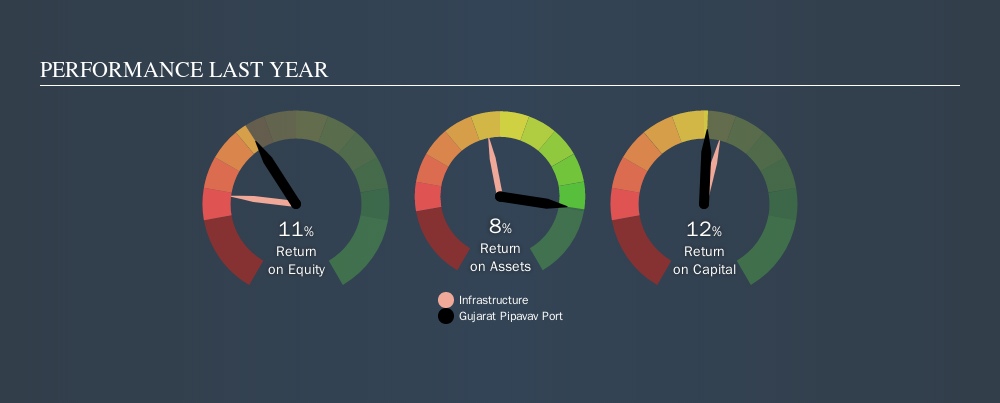Today we'll evaluate Gujarat Pipavav Port Limited (NSE:GPPL) to determine whether it could have potential as an investment idea. To be precise, we'll consider its Return On Capital Employed (ROCE), as that will inform our view of the quality of the business.
Firstly, we'll go over how we calculate ROCE. Second, we'll look at its ROCE compared to similar companies. Finally, we'll look at how its current liabilities affect its ROCE.
What is Return On Capital Employed (ROCE)?
ROCE measures the amount of pre-tax profits a company can generate from the capital employed in its business. In general, businesses with a higher ROCE are usually better quality. Ultimately, it is a useful but imperfect metric. Renowned investment researcher Michael Mauboussin has suggested that a high ROCE can indicate that 'one dollar invested in the company generates value of more than one dollar'.
How Do You Calculate Return On Capital Employed?
The formula for calculating the return on capital employed is:
Return on Capital Employed = Earnings Before Interest and Tax (EBIT) ÷ (Total Assets - Current Liabilities)
Or for Gujarat Pipavav Port:
0.12 = ₹2.8b ÷ (₹25b - ₹2.3b) (Based on the trailing twelve months to June 2019.)
So, Gujarat Pipavav Port has an ROCE of 12%.
View our latest analysis for Gujarat Pipavav Port
Does Gujarat Pipavav Port Have A Good ROCE?
When making comparisons between similar businesses, investors may find ROCE useful. Using our data, we find that Gujarat Pipavav Port's ROCE is meaningfully better than the 5.9% average in the Infrastructure industry. We consider this a positive sign, because it suggests it uses capital more efficiently than similar companies. Separate from how Gujarat Pipavav Port stacks up against its industry, its ROCE in absolute terms is mediocre; relative to the returns on government bonds. Readers may find more attractive investment prospects elsewhere.
The image below shows how Gujarat Pipavav Port's ROCE compares to its industry.

Remember that this metric is backwards looking - it shows what has happened in the past, and does not accurately predict the future. Companies in cyclical industries can be difficult to understand using ROCE, as returns typically look high during boom times, and low during busts. ROCE is only a point-in-time measure. Since the future is so important for investors, you should check out our free report on analyst forecasts for Gujarat Pipavav Port.
Gujarat Pipavav Port's Current Liabilities And Their Impact On Its ROCE
Short term (or current) liabilities, are things like supplier invoices, overdrafts, or tax bills that need to be paid within 12 months. Due to the way ROCE is calculated, a high level of current liabilities makes a company look as though it has less capital employed, and thus can (sometimes unfairly) boost the ROCE. To counter this, investors can check if a company has high current liabilities relative to total assets.
Gujarat Pipavav Port has total assets of ₹25b and current liabilities of ₹2.3b. As a result, its current liabilities are equal to approximately 9.0% of its total assets. With low levels of current liabilities, at least Gujarat Pipavav Port's mediocre ROCE is not unduly boosted.
Our Take On Gujarat Pipavav Port's ROCE
Based on this information, Gujarat Pipavav Port appears to be a mediocre business. Of course, you might also be able to find a better stock than Gujarat Pipavav Port. So you may wish to see this free collection of other companies that have grown earnings strongly.
I will like Gujarat Pipavav Port better if I see some big insider buys. While we wait, check out this free list of growing companies with considerable, recent, insider buying.
We aim to bring you long-term focused research analysis driven by fundamental data. Note that our analysis may not factor in the latest price-sensitive company announcements or qualitative material.
If you spot an error that warrants correction, please contact the editor at editorial-team@simplywallst.com. This article by Simply Wall St is general in nature. It does not constitute a recommendation to buy or sell any stock, and does not take account of your objectives, or your financial situation. Simply Wall St has no position in the stocks mentioned. Thank you for reading.
About NSEI:GPPL
Gujarat Pipavav Port
Engages in the construction, operation, and maintenance of port at Pipavav in Gujarat, India.
Flawless balance sheet with solid track record.
Market Insights
Community Narratives


